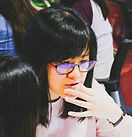
Student
Projects
Read the original research papers written by our coursemates collaboratively on this field trip here.
After having elicited linguistic data during the field trip, our coursemates were required to produce original research papers on the Malaysian languages with specific focus in groups of 3 to 4. They were allowed to work on any topic as they desire, given that the topics were feasible and could be well argued for. The groups worked on varietal phonetics, cognitive-syntax interface, grammatical semantics and syntactic constructions respectively. Scroll down to read their full papers!
Ada, Alexis,
Aurora
Agnes, Christy, Judy
Anna, Sonia,
Teresa, Yuki
Brian, Chapman,
Jason


Ada Liu

Alexis Shiu

Aurora Ng
. . .
A Cross-Variety Acoustic Description of Monophthongal Vowels: Bahasa Melayu, varieties of Penang, Perak and Sabah
Paper by Ada Liu, Alexis Shiu & Aurora Ng
ABSTRACT
This paper investigates the acoustic characteristics of five Malay varieties, including Bahasa Melayu, Penang, Sabah, Perak and Chinese Malay. Each variety is represented by one speaker. The aim of the present study is to compare the vowel features of Bahasa Melayu and the four remaining varieties. Before comparing, features of varietal vowels are analysed descriptively by using tongue height and vowel backness as parameters. In addition, the two parameters are represented by first formant (F1) and second formant (F2) in Hz unit. In order to facilitate the analysis, the formants are normalised into Bark frequency scale. Moreover, the vowel inventory adopted in this paper includes 6 monophthongs, which are /i/, /e/, /ə/, /a/, /o/ and /u/. In our discussion, it is discovered that /i/, /o/ and /u/ are the most stable vowels across varieties and among the three word positions (i.e.: initial, medial and final). Furthermore, front vowels tend to undergo shifting, often to a central position. Apart from vowel centralisation, vowel shifting is commonly discovered for /e/, /a/ and /ə/. For /e/ and /a/, they are likely to shift to /ə/, while for /ə/, it tends to shift to /ʌ/.

Agnes Chan

Judy Cheng

Christy Lau
. . .
Comparison of the usage of ‘CUT and BREAK’ verbs between Malay and Chinese: A cross-linguistic view
Paper by Agnes Chan, Judy Cheng & Christy Lau
ABSTRACT
The aim of this quantitative study was to investigate cross-linguistic systems by exploring the categorization of encoding the “cutting” and “breaking” events between Chinese and Malay. The participants of the study were drawn from the university campus in Malaysia and Hong Kong. This study was designed based on the everyday event “cutting” and “breaking” and the data were obtained during random daytime activities through interviews. Therefore, in this paper, speech recordings and written data were collected from 19 participants in Malaysia and Hong Kong and were analyzed in order to evaluate what the cognitive conceptualization focuses more among speakers of the two contrasting languages. The data showed four major factors affecting participants’ choice of words, which are the types of instrument, the existence of agent, the condition of the affected objects and the type of those objects. Along with reviewing several researches and literatures, the findings reveal a significant agreement on the construction of these events among Chinese and Malay in spite of the difference in their own linguistic systems. A possible explanation of a universal conceptualization on “cutting and breaking is from then raised. In closing, the paper also addresses the limitations encountered for the research and draws out any potential future directions that can be probed into. This result may suggest that there are more interrelated constraints yet to be discovered in the classification of human events.

Anna Wong

Sonia Chan

Teresa Ho

Yuki Tang
. . .
Reflection of Tense and Aspect in Malay:
the Grammatically Non-Tensed Language
Paper by Anna Wong, Sonia Chan, Teresa Ho & Yuki Tang
ABSTRACT
This report aims at investigating how tense and aspect are expressed in Malay. On the basis of the fieldwork undertaken in Malaysia, this report provides a comprehensive analysis of the inventory of tense and aspect indicators of Malay while the grammatical semantics of the indicators in question will be examined. The report demonstrates that tense in Malay must be analysed in connection with aspects. At the syntactic level, there is the grammatical category of aspect. At the lexical level, verbs are classified into different aspectual meanings. In Malay, there are analytical markers such as meN- and ter- which contribute to the expression of aspectual and/ or temporal relations. However, the usage of these analytical markers is limited. In most cases, Malay relies on particles or independent words, usually adverbs to express the aspect denoted by a verb.

Brian Tseung

Chapman Chung

Jason Lee
. . .
Malay Locative Constructions for Static and Dynamic Spatial Relations
Paper by Brian Tseung, Chapman Chung & Jason Lee
ABSTRACT
Malay is an Austronesian language spoken widely in Malaysia. An experiment employing ‘Frog Story’ pictures, photos showing objects’ positions and clips displaying movement of mankind was conducted to elicit locative constructions in Malay. This report is showing that Malay adopts general locative, goal-oriented, source-oriented and path-oriented prepositions. Static positions are also configured in Malay through 4 strategies: verbless, copula, postural and resultative complement constructions. As for movement-related motion verbs, Malay displays all features fitting into satellite-framed, verb-framed and equipollent languages.











